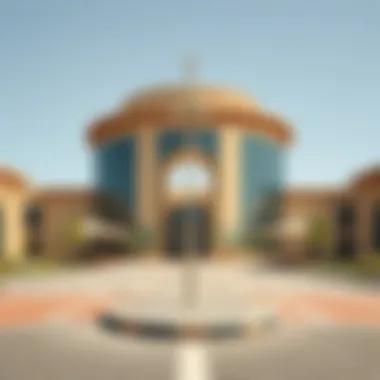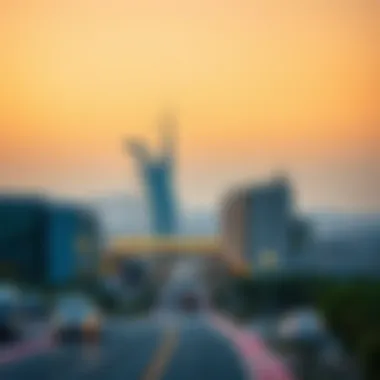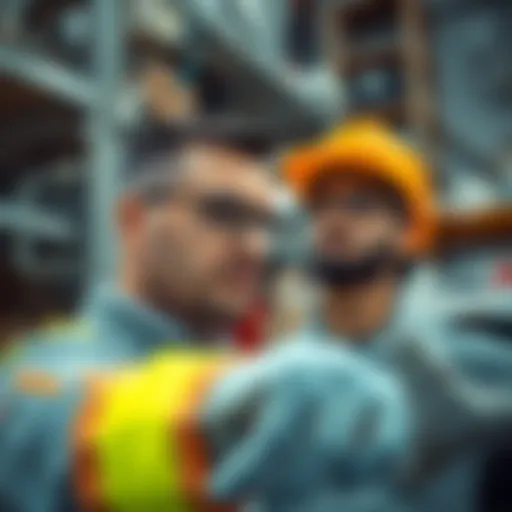Exploring the Distance from Ras Al Khaimah to Dubai


Intro
Ras Al Khaimah and Dubai, two pivotal locales within the United Arab Emirates, boast a profound connection that extends beyond mere kilometers. As one gazes at the map, the distance between the two cities might seem insignificant—roughly 112 kilometers or about 70 miles. However, the implications of this proximity ripple throughout various sectors, particularly in real estate and tourism. Both cities, distinct in their character yet intertwined economically and culturally, draw serious consideration from investors and visitors alike.
In this article, we aim to unpack the intricate facets of the relationship between Ras Al Khaimah and Dubai. We’ll delve into the current trends shaping Dubai's real estate market, analyze property prices along with forecasts, and provide essential guidance for those keen on investing in the growing Emirati landscape. Whether one is a seasoned investor or a curious traveler, understanding how these two cities relate can provide a strategic edge in making informed decisions.
Market Insights
The real estate market in Dubai is a dynamic environment. With the city constantly evolving, it’s essential for anyone looking to invest to stay aware of the latest trends.
Current Trends in Dubai Real Estate
In the past few years, Dubai has witnessed a remarkable transformation in its property sector. The demand for residential properties continues to surge, driven by factors such as:
- An influx of expatriates seeking to make Dubai their home.
- Major projects like Expo 2020 which have spurred infrastructure development.
- The easing of visa regulations and incentives for foreign investors, making Dubai an attractive proposition.
- The rise of luxury and affordable housing, catering to a diverse population.
Given these trends, the market is expected to remain buoyant, with a focus on sustainable developments. Properties in areas such as Palm Jumeirah and Dubai Marina showcase both luxury and lifestyle appeal, while neighborhoods like Dubai Hills Estate offer family-friendly environments tailored for long-term residents.
Analysis of Property Prices and Forecasts
As of late 2023, property prices in Dubai have shown resilience in the face of global economic fluctuations. Reports suggest that apartment prices in the city have increased by approximately 16%, while villas have surged even higher—up to 22% year-on-year.
- Luxury Segment: High-end properties remain in demand, with Dubai attracting wealthy buyers from across the globe. Areas like Downtown Dubai frequently see transaction values soaring.
- Affordable Housing: On the flip side, there is a keen interest in more affordable segments. Developments in areas like Dubailand and Jumeirah Village Circle (JVC), for instance, cater to a growing middle-class demographic seeking value without sacrificing quality.
Market forecasts indicate a continued upward trajectory. However, potential investors should remain vigilant about external influences such as fluctuating oil prices and geopolitical factors that might sway the UAE economy.
"Understanding local market nuances is critical for anyone considering property investment in Dubai. With the rapid pace of change, information is your most valuable asset."
Investment Guidance
Investing in Dubai's real estate can be both exciting and overwhelming. Here are a couple of practical tips to steer first-time buyers in the right direction.
Tips for First-Time Buyers in Dubai
- Research Thoroughly: Familiarize yourself with the local market conditions, trends, and property types.
- Engage a Reliable Real Estate Agent: Working with a knowledgeable agent can significantly ease the buying process.
- Consider the Location: The right location can bolster future resale value, so choose wisely.
- Understand Legalities: Ensure that you comprehend the laws surrounding property ownership, especially for expatriates.
- Get Your Finances in Order: Know your budget and have your financing mechanisms ready before starting your search.
Key Factors to Consider for Property Investment
When evaluating potential investments, it’s vital to consider:
- Vacancy Rates: Understanding vacancy trends in a given area can provide insights into potential rental returns.
- Future Developments: Stay informed about planned infrastructure or commercial projects that may enhance property value.
- Community Services: Do your homework on amenities—schools, hospitals, transportation links can make a substantial difference in attracting tenants or buyers.
Remember, a well-informed decision today can pave the way for substantive returns tomorrow. For additional insights and property listings, you may want to explore resources like Dubai Land Department, Property Finder, or various realty forums on Reddit.
Stay tuned for more detailed analyses and forecasts as we explore the interconnected dynamics of Ras Al Khaimah and Dubai.
Understanding Ras Al Khaimah
Ras Al Khaimah, often referred to by its initials RAK, stands out as one of the seven emirates that comprise the United Arab Emirates. This section delves into the significance of understanding Ras Al Khaimah within the broader context of its relationship to Dubai—an emirate known for its towering skyscrapers and bustling urban life. To navigate the dynamics between these two locations, one must consider geography, culture, and economic factors.
Geography and Climate
Ras Al Khaimah boasts a unique geographical position, situated at the northern part of the UAE. This place is bordered by the Hajar Mountains which gently rise into the skyline, offering a dramatic backdrop that is both breathtaking and crucial for the region’s climate. Understanding its climate categories is equally vital.
- Desert Climate: Characterized by long, hot summers which can test any outdoor enthusiast, with temperatures reaching up to 50 degrees Celsius in the peak months.
- Mild Winters: The winters offer a stark contrast, with cooler conditions and temperatures ranging between 14 to 24 degrees Celsius, making it pleasant for various outdoor activities.
This geographical and climatic understanding not only influences daily life for residents but also impacts tourism and potential business ventures.
Cultural Heritage
The cultural tapestry of Ras Al Khaimah is rich and multifaceted, weaving together Bedouin traditions with contemporary influences. While it may not always hog the limelight like Dubai, RAK's cultural heritage holds significant value.
- Historical Sites: The region showcases ancient forts and archaeological treasures such as the Dhayah Fort and the remnants of the Julfar city.
- Annual Festivals: Events like the Ras Al Khaimah Fine Arts Festival illuminate local art and heritage, drawing in visitors and investors alike.
Understanding the cultural undercurrent of Ras Al Khaimah is essential for anyone exploring investment or relocation opportunities. The essence of Ras Al Khaimah is deeply embedded in its traditions, which potentiate a warm welcome for newcomers.
Economic Overview
Ras Al Khaimah may not rival Dubai in scale, but its economy is steadily growing. Various sectors contribute to this development, and understanding them provides critical insights for potential investors.
- Tourism: Aiming to capture a slice of the tourism pie, RAK is increasingly becoming popular for those looking for a quieter getaway compared to Dubai. The stunning beaches and outdoor adventures attract visitors year-round.
- Manufacturing and Industry: Known as the manufacturing hub of the UAE, the emirate produces everything from cement to ceramics, supplying not just the local market but also regional exports.
- Real Estate Growth: With comparatively lower property prices, the area offers lucrative opportunities for those interested in the real estate market, especially for expatriates looking for a more affordable living option.
In summary, grasping the economic landscape of Ras Al Khaimah is paramount for anticipating future trends that could influence property investments and lifestyle decisions.
"Understanding the local environment—be it cultural, geographical, or economic—serves as a bedrock for making informed decisions in Ras Al Khaimah."


This exploration lays the groundwork for evaluating how the proximity between Ras Al Khaimah and Dubai influences various aspects, particularly in the realms of travel and property investment.
Dubai: A Quick Overview
Dubai serves as a vital hub in the United Arab Emirates, embodying a blend of tradition and modernity that continues to attract investors, expatriates, and tourists alike. Understanding Dubai's landscape provides essential context for appreciating its proximity to Ras Al Khaimah, a connection that shapes both travel behavior and property investment dynamics.
Urban Development
Dubai’s urban development is nothing short of extraordinary. Over the past few decades, the city has transformed from a modest trading port into a thriving global metropolis. The skyline, dominated by modern architectural marvels, symbolizes this rapid development. Notable structures like the Burj Khalifa and the Palm Jumeirah have redefined not just the city's aesthetic but also its economic potential.
- Key Highlights of Urban Development:
- Extensive infrastructure projects, including the Dubai Metro, have eased transportation, linking various parts of the city and beyond.
- Ongoing projects like the Dubai Creek Tower aim to further enhance the city’s global standing.
- Smart city initiatives contribute to sustainable living, attracting forward-thinking businesses and residents.
The urban sprawl of Dubai impacts the Ras Al Khaimah region significantly. Potential homebuyers and investors often consider the urban development in Dubai as a barometer for growth in the neighboring emirate.
Tourism Appeal
Dubai is widely recognized for its robust tourism appeal, attracting millions from around the world each year. The city offers a range of experiences, from luxury shopping in the Dubai Mall to cultural excursions in Al Fahidi Historical District. The tourism sector's contribution isn't just economic; it builds cultural bridges, enhancing the emirate’s global image.
- Attractions Influencing Tourism:
- Culinary Diversity: Visitors get to taste flavors from every corner of the globe, with options ranging from street food to Michelin-starred restaurants.
- Adventure Activities: Dubai's adventurous spirit comes alive through desert safaris, skydiving, and water sports, catering to thrill-seekers.
- Cultural Events: Festivals like the Dubai Shopping Festival attract tourists, significantly spiking hotel occupancy rates and local spending.
Ras Al Khaimah’s close proximity to this tourism hotspot presents opportunities for day trips and extended stays, making it a desirable location for investment in hospitality and leisure sectors.
Real Estate Market Trends
The real estate market in Dubai exhibits a unique momentum driven by both local and international demand. Investors eye Dubai for its potential returns, and understanding these trends is critical for anyone considering investment in the surrounding regions.
- Current Market Trends:
- Recovery from previous downturns showcases a strong upward trajectory, with property values steadily increasing.
- A rising preference for off-plan projects indicates buyer confidence in the long-term growth of the market.
- Luxury and affordable housing segments are both performing well, reflecting diverse buyer demographics.
The attractiveness of Dubai's real estate market influences residential and commercial investment trends in Ras Al Khaimah. Many potential homeowners view the connectivity to Dubai as a compelling factor, ensuring the interest in Ras Al Khaimah remains robust.
Unfortunately, overlooking the intricate connections between Ras Al Khaimah and Dubai could mean missing valuable investment opportunities.
The intertwining of Dubai’s rapid urban growth, its formidable tourism sector, and its thriving real estate landscape offers a unique backdrop against which the distance between Ras Al Khaimah and Dubai should be considered. Understanding these elements is pivotal for anyone looking to make informed decisions amidst the captivating dynamics of the UAE.
Distance Measurement
Understanding the distance between Ras Al Khaimah and Dubai is crucial for various stakeholders. It's not just about kilometers; it’s about the implications of that distance on travel, commerce, and real estate. This section aims to dissect the importance of distance measurement in terms of practicality, convenience, and economic opportunity.
Kilometers from Ras Al Khaimah to Dubai
The physical distance between Ras Al Khaimah and Dubai is approximately 112 kilometers. This metric serves as a foundational measure for how accessible one location is from another. It's not merely a number on a signpost; it practically defines travel times, commuting habits, and potential market reach for businesses. For instance, knowing this distance allows homeowners and investors to gauge how quick or long their commutes might be when considering relocation or investment.
Travel Routes
Main highways
Traveling via main highways, primarily the Sheikh Mohammed Bin Zayed Road, significantly cuts down the time between Ras Al Khaimah and Dubai. This route is well-maintained and offers good signage, making it favorable for both daily commuters and tourists. The wide lanes and multiple speed limits cater to various driving habits, thus enhancing traffic flow. A significant benefit of this highway is the convenience it provides – a direct route that allows one to overlook scenic stretches of the desert landscape.
However, heavy freight trucks also use this highway, which can lead to occasional congestion. Navigating around these vehicles may require patience during peak hours, but the straightforward nature of the route still makes it the go-to choice for many travelers.
Alternative routes
For those looking to veer off the beaten path, alternative routes such as the coastal road add a layer of exploration to the journey. This road brings with it breathtaking views of the Arabian Gulf, making the trip not just a transit but an experience. Aside from the aesthetic appeal, this option can sometimes be faster during traffic jams on the main highways.
Still, drivers should know that with this added beauty comes a twisty road structure that might not be ideal for everyone, particularly those prone to motion sickness. While it offers a respite from the usual highway grind, some may find the journey a tad laborious compared to the more straightforward main routes.
Travel Duration
By car
Driving from Ras Al Khaimah to Dubai typically takes about an hour to an hour and a half, depending on traffic conditions. This possibility of quick travel time makes it a practical choice for many expatriates working in Dubai but residing in Ras Al Khaimah. Additionally, taking into account the time saved by using express routes makes driving a highly favorable option.
By public transportation
Public transportation, such as buses, can stretch this travel time to almost two hours or more. While the amenities are decent, and buses are often well-maintained, schedules can be a bit erratic. However, this option is economical and is often used by those who prefer not to drive in busy traffic or want to save on fuel costs. Buses also provide a chance to engage with fellow travelers, which can be an added social experience.
Traffic considerations
Traffic conditions are the wildcard when measuring distance. Since Ras Al Khaimah and Dubai are both major hubs with heavy vehicle flow, instances of congestion can create significant delays. Travelers may want to keep an eye on peak hours, usually early mornings and evenings, to ensure a more pleasant journey. The unpredictability of traffic also emphasizes the importance of real-time navigation apps, which provide updates and alternative suggestions, making it easier for drivers to adapt on the go.


Modes of Transportation
Understanding the various modes of transportation between Ras Al Khaimah and Dubai is crucial for not just travelers, but also for investors and expatriates looking for convenient ways to navigate the area. Knowing how to get around efficiently informs travel plans and also highlights the extent of interconnectivity in the UAE. From private vehicles to public transportation options, the choices available greatly impact daily commuting, tourism flows, and even real estate prospects in both regions.
Private Cars
Using private cars for travel between Ras Al Khaimah and Dubai is often the most common choice. With well-maintained highways, the drive can be quite smooth. The journey typically takes about an hour and a half, depending on traffic conditions. Having your own vehicle gives flexibility—it's easy to make spontaneous stops or detours along the way, perhaps to check out a scenic spot or grab a bite to eat.
Driving also allows expatriates and homeowners to discover hidden gems in the landscape that aren't as accessible via public transit. For instance, taking a road trip can lead to breathtaking vistas, allowing one to experience the natural beauty of the UAE firsthand.
Buses and Coaches
Public transport in the form of buses and coaches is another viable option for traversing this distance. Buses are often inexpensive and they run regularly, making them quite convenient for daily commutes or visits to Dubai. Routes connecting Ras Al Khaimah to Dubai feature air-conditioned coaches which make the journey comfortable, particularly during the hotter months.
However, while taking the bus is cost-effective, it lacks the same level of flexibility that a private car offers. Passengers need to adhere to the schedule and the routes available.
Here's a quick comparison of bus travel:
- Affordability: Lower costs than a private car.
- Comfort: Many buses are air-conditioned.
- Schedule: Operates on fixed times, reducing flexibility.
Taxis and Ride-Sharing Services
For those who prefer to avoid driving altogether, taxis and ride-sharing services like Uber or Careem provide another alternative. They can be summoned directly from mobile apps, making it quite easy to hop into one and head to your destination without the hassle of parking.
Taxis are readily available in both Ras Al Khaimah and Dubai, but the costs can add up, especially if you’re making multiple trips. Ride-sharing services generally offer a slightly more cost-efficient way to travel while providing real-time tracking and exact fare estimates.
"Choosing the right mode of transportation can significantly enhance your travel experience and save both time and money."
In a nutshell, whether you're commuting for work, visiting attractions, or considering property investments, understanding these transportation options between Ras Al Khaimah and Dubai will make the journey not only more pleasant but also more strategic.
Impact on Real Estate
The relationship between Ras Al Khaimah and Dubai holds profound implications for the real estate market in this region. With the increasing interconnectivity between the two emirates, primarily driven by ongoing infrastructural developments, the impact on property values and investment opportunities cannot be overstated. For investors and homeowners, understanding these dynamics is crucial. The proximity of these two areas can influence property demand, pricing, and the desirability of residential and commercial locations.
Property Values Comparison
When comparing property values between Ras Al Khaimah and Dubai, it's evident that location serves as a pivotal factor. Dubai, known for its towering skyscrapers, luxury apartments, and extensive amenities, generally commands higher property prices. Buyers often associate property in Dubai with prestige and accessibility to international markets. Conversely, Ras Al Khaimah presents a unique allure: it offers more competitive pricing without sacrificing quality of life. This disparity creates a compelling choice for those looking at investment versus residential options.
- Average Property Prices: In Dubai, you might find luxury apartments ranging from AED 1 million to several million, whereas Ras Al Khaimah offers quality apartments starting from AED 300,000, appealing to budget-conscious investors.
- Evolving Markets: While Dubai remains attractive for affluent buyers, Ras Al Khaimah's emerging market shows potential for growth, making it a hidden gem for smart investors.
The growing appeal of Ras Al Khaimah’s landscapes and its focus on ecotourism can elevate its property values in the coming years as more businesses and amenities set up in the emirate.
Investment Opportunities
Residential
Residential properties in Ras Al Khaimah offer a variety of choices, from villas to mid-rise apartments, catering to different tastes and budgets. The accessibility from Dubai enhances its appeal for those who prefer a quieter lifestyle while maintaining a relatively short commute backward and forward.
One key characteristic of buying residential properties here is the significant return on investment, particularly given the rising demand for family-friendly living spaces. Investors find Ras Al Khaimah’s growing neighborhoods have unique features, such as proximity to natural beauty like mountains and beaches. However, it’s essential to consider that while property prices are lower, the resale market might not be as active compared to Dubai’s bustling environment—thus impacting liquidity for buyers.
- Advantages: More spacious properties for families, lower prices, and a serene environment.
- Disadvantages: Slower market liquidity and fewer luxury amenities compared to Dubai.
Commercial
The commercial real estate sector in Ras Al Khaimah is also blossoming, driven by an influx of businesses looking for cost-effective office spaces. Companies find it beneficial to establish operations there due to lower overhead costs compared to Dubai’s competitive environment.
The key characteristic of Ras Al Khaimah’s commercial offerings is the focus on creating business-friendly zones that encourage startups and established companies alike. The unique feature is the economic free zones that attract foreign investments without the requirement for local partnerships—something that boosts demand for commercial properties. Conversely, while commercial prospects can be enticing, investors should evaluate the market saturation risk and regional economic conditions, which may differ from the cosmopolitan Dubai scene.
- Advantages: Lower establishment costs and access to a supportive government.
- Disadvantages: Potentially limited customer base compared to Dubai; thus, higher risks for newcomers.
Expatriate Preferences
Expatriates play an essential role in the real estate dynamics between Ras Al Khaimah and Dubai. Many expats drawn to Dubai's high-energy lifestyle find Ras Al Khaimah appealing for its tranquility and growing expat community. The appeal often lies in affordable housing combined with natural beauty and less commuting stress.
Ras Al Khaimah has been gaining traction among expats looking for a more balanced lifestyle—less hustle, yet a close enough connection to the vibrant life in Dubai. As developments progress within Ras Al Khaimah, such as community-focused amenities and better infrastructural ties to Dubai, more expatriates are likely to consider it as a viable living option.
Moreover, the increasing number of expatriate families seeking quality over quantity in terms of living space adds to the demand for housing in this region. This demand shapes property investments, making it a compelling market for future growth.
Tourism and Recreation
Tourism and recreation act as a cornerstone in understanding the relationship between Ras Al Khaimah and Dubai. Both emirates offer a variety of experiences that cater to a wide range of tastes and preferences, making the dialogue between them not just about distance but also about cultural and recreational exchange. The proximity of Ras Al Khaimah to Dubai enables visitors to enjoy the diverse attractions each location has to offer while considering the benefits and logistical aspects of their travels.
The tourism industry significantly impacts local economies and stimulates job creation, especially in regional areas such as Ras Al Khaimah. The influx of visitors keeps businesses buzzing and supports various sectors, from hospitality to entertainment. Furthermore, understanding tourists' recreational needs aids in planning better infrastructure and development, which ultimately benefits long-term investors and homeowners looking at these emerging markets.
Attractions in Ras Al Khaimah


Ras Al Khaimah is often a hidden gem compared to its big brother, Dubai. However, it boasts several attractions that shouldn’t be overlooked. Among them, the Jebel Jais, the tallest mountain in the UAE, offers stunning views and exhilarating activities, including zip-lining, which is one of the longest in the world. Visitors can also relish the tranquility of the Al Hamra Marina and Yacht Club, where water sports enthusiasts find their paradise.
- Historical Sites: The Dhayah Fort, dating back to the 16th century, allows visitors to step back in time while enjoying breathtaking vistas of the surrounding date palms.
- Adventure Activities: The Ras Al Khaimah Pearl Journey provides a unique opportunity for tourists to engage in the traditional methods of pearl diving, linking them to the emirate’s maritime heritage.
In short, these attractions provide a refreshing contrast to the bustling life in Dubai, adding layers of cultural depth and adventure to the regional tourism mosaic.
Comparative Attractions in Dubai
On the flip side, Dubai tends to draw attention with its iconic landmarks and entertainment options that are equivalent to none. The Burj Khalifa, a marvel of modern engineering, dominates the skyline and is a must-visit. The Dubai Mall, offering everything from shopping to an indoor aquarium, spells luxury.
- Cultural Sites: The Dubai Opera presents an elevated cultural experience that is unmatched in the UAE. It attracts renowned performers and a diverse clientele.
- Entertainment Facilities: Theme parks such as IMG Worlds of Adventure and Motiongate provide thrills and activities for families, ensuring that there are options for all age groups.
While Ras Al Khaimah offers a quieter, more relaxed pace of life, Dubai's options cater to the high-energy traveler, promoting an intriguing juxtaposition that enhances the appeal of both emirates.
Day Trips and Visits
For those looking to make the most of their time, day trips between Ras Al Khaimah and Dubai are both convenient and rewarding. The drive, typically taking around 90 minutes, allows for spontaneity in travel plans. Visitors often make a rhythm of trips back and forth.
- Day Itinerary Suggestion: Start with breakfast at a charming café in Ras Al Khaimah, followed by a morning hike in Jebel Jais before heading to Dubai for lunch at the Atlantis resort. The afternoon could see visits to The Dubai Fountain or an afternoon at the beach.
- Best Times to Visit: Weekdays might offer a more serene experience compared to weekends when both areas experience a spike in tourist activity.
Exploring both Ras Al Khaimah and Dubai within the span of a day can yield popular experiences, making it a convenient endeavor for both tourists and expatriates who wish to soak up everything the UAE has to offer.
Proximity between Ras Al Khaimah and Dubai enhances the opportunities for tourism, creating a unique synergy that benefits visitors and local economies alike.
Challenges of Proximity
The proximity of Ras Al Khaimah (RAK) and Dubai, while advantageous in many respects, brings its own set of challenges that cannot be ignored. As more individuals and businesses look to bridge the gap between these two locations, understanding these hurdles becomes paramount. Factors such as infrastructure limitations and overcrowding issues play significant roles in both the daily lives of residents and the investment landscape. Investors, homeowners, and expatriates must grasp these intricacies to make informed decisions in this rapidly evolving region.
Infrastructure Limitations
One of the most pressing challenges is the current state of infrastructure. Despite significant developments in RAK, the area is still behind Dubai in terms of transport networks and facilities. Roads connecting the two locations, while functional, can be problematic. For instance, during peak hours, the traffic along the Sheikh Mohammed Bin Zayed Road can resemble a crawfish, with vehicles inching along at a snail's pace. This can lead to frustrating delays for commuters, impacting the overall appeal of living or investing in Ras Al Khaimah.
- Limited Public Transport: Public transport options are still limited compared to what’s available in Dubai. Buses operate but do not run as frequently as needed, making car ownership a necessity for many.
- Underdeveloped Amenities: RAK's amenities, including shopping complexes and healthcare facilities, are still catching up to Dubai's expansive offerings, making it less attractive for potential residents.
Overcrowding Issues
As Ras Al Khaimah grows in popularity due to its natural beauty and relatively affordable real estate, the potential for overcrowding looms larger by the day. This growth, coupled with Dubai’s draw, has created a scenario where amenities and housing are stretched thin. Overcrowding leads to several complications for both current residents and future investors.
- Increased Demand for Housing: The influx of new residents pushes demand for housing to new heights. Property prices may see rapid inflation, making it challenging for newcomers, especially expatriates, to find affordable accommodations.
- Strained Infrastructure: Overcrowding exacerbates issues with infrastructure. Public facilities can become overloaded, translating to slower services and diminished quality of life. Facilities like schools and hospitals may find themselves overwhelmed by the rising population, leading to longer waiting times and reduced service quality.
"As the population increases, the available resources remain static, leading to a battle over everything from school spots to parking spaces. Successful integration of infrastructure is critical."
In sum, while the closeness of Ras Al Khaimah and Dubai presents numerous opportunities, these challenges indicate that one must tread carefully. Investors and homeowners need to consider not just the short-term gains but also the long-term implications of these infrastructural and societal hurdles. Ignoring these factors might not just affect daily living but could also skew investment outcomes. By understanding these dynamics, stakeholders can better navigate the complexities of this unique region.
Future Developments
The next wave of changes around Ras Al Khaimah (RAK) and Dubai holds considerable potential for transforming the landscape of both areas. Future developments are not just about construction; they encapsulate the vision of connectivity, economic growth, and an enriched quality of life. As urban areas get more congested, planners and investors are recognizing the need for a path that not only eases travel but also enhances living conditions. This is where the future development initiatives come into play, serving as a catalyst for various sectors, especially real estate and tourism.
Planned Infrastructure Projects
Planned infrastructure projects aim to improve transport links and utilities between Ras Al Khaimah and Dubai, making it easier than ever to commute and interact. Some significant projects on the drawing board include:
- Expanded Road Networks: Upgrades to highways connecting RAK and Dubai will help facilitate smoother traffic flow, effectively cutting down travel time.
- Rail Link Proposals: There are ongoing discussions regarding a rail link that would connect the city centers, allowing for an efficient, high-capacity public transportation alternative.
- Smart City Initiatives: The push for smart technologies in urban planning promises enhanced management of resources such as water and energy, potentially making both regions more sustainable.
These projects aren't just pie-in-the-sky ideas. The Ras Al Khaimah Economic Zone (RAKEZ) is already working closely with investors and the government to attract new businesses through these upgrades. As infrastructure improves, the real estate market will likely benefit from an influx of new residents and investors eager to take advantage of the enhanced living conditions.
Vision for Urban Integration
Urban integration refers to the holistic approach of creating seamless connections between RAK and Dubai, ensuring that inhabitants feel part of a larger community. This vision isn't merely about physical connectivity; it also focuses on social cohesion and shared economic opportunities.
- Community Development Projects: Future plans include mixed-use developments that encourage shopping, dining, and entertainment in close proximity to residential areas. Investors are likely to find opportunities in these multifaceted spaces, which can cater to both locals and tourists.
- Cultural Exchange Initiatives: As the distance between RAK and Dubai shrinks with improved infrastructures, there is a chance for heightened cultural exchange. Joint events could showcase the best of Emirati culture, art, and cuisine, creating a tourist-friendly atmosphere that excites both regions.
- Sustainable Practices: With a clear vision for urban integration comes the responsibility of making these communities sustainable. Projects focused on eco-friendly building materials and renewable energy are expected to flourish, drawing attention from conscientious investors.
In summation, the insights on future developments underscore the necessity for a strategic approach to urban planning and infrastructure improvement between Ras Al Khaimah and Dubai. The impact these initiatives will have on real estate, tourism, and the overall living experience cannot be overstated, making it a crucial area of interest for investors, homeowners, and expatriates alike.
End
Understanding the relationship between Ras Al Khaimah and Dubai involves more than just knowing how far apart they are. The distance has significant implications, touching upon travel, tourism, and real estate. This article has offered insights into how these two locations interact with one another, providing valuable information for investors and visitors alike.
Summary of Key Insights
Reflecting on the key insights, we can observe the following points that emerge from the exploration of Ras Al Khaimah and Dubai:
- Distance Matters: The geographical proximity of these two cities creates various advantages. Investors can quickly assess property value differences, while tourists have easy access to diverse attractions, enhancing their experience in the UAE.
- Transport Options: Travel methods between these areas range from private vehicles to public transport, ensuring that everyone can find a suitable option according to their needs and preferences.
- Cultural Connectivity: The cultural bonds connecting Ras Al Khaimah and Dubai play a pivotal role in attracting expatriates and tourists, making the journey worthwhile and enriching.
- Real Estate Dynamics: The fluctuating real estate market reactions signify that investor interest often grabs attention owing to the unique combination of affordability and luxury that Ras Al Khaimah offers in relation to Dubai’s bustling market.
Final Thoughts on Proximity
As we come to a close on this discourse, it’s clear that the synergy between Ras Al Khaimah and Dubai is not just beneficial, it is critical. Given the sharp rise of residential and commercial real estate in both locations, the geographical closeness allows potential investors and homeowners to make informed decisions. The evolving infrastructure projects are set to strengthen this relationship further, while cultural exchanges enrich the fabric of both cities.
To sum it up, being situated just a stone's throw away enhances the living experience significantly. With future developments on the horizon, now may just be the best time to explore the opportunities this remarkable region offers. Moreover, understanding these dynamics may lead to fruitful investments and a chance to be a part of a region teeming with potential.
"Proximity doesn’t just make the hearts grow fonder; it creates opportunities that might just change your life."
For further reading on Ras Al Khaimah and Dubai, consider visiting Wikipedia or Britannica.







